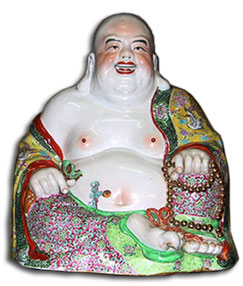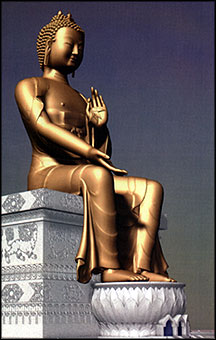

Chinese
depiction: often referred to as the Laughing Buddha
(Japanese,
Miroku; Chinese, Mi-lo Fwo; Tibetan, Byams-pa;
Vietnamese, Di-lac; Korean, Mi-rug)
 According
to some Buddhist traditions, the period of the Buddhist
Law is divided into three stages: a first period of 500
years, of the turning the Wheel of the Law; a second period
of 1,000 years, of the deterioration of the Law, and a third
period of 3,000 years (called Mappo in Japan) during which
no one practises the Law. After this, Buddhism having disappeared,
a new Buddha will appear who will again turn the Wheel of
the Law. This future Buddha is still in the Tusita heaven,
in the state of a Bodhisattva. Gautama Buddha himself will
enthrone him as his successor. The name means 'benevolence'
or 'friendship'. He is now living his last existence as
a Bodhisattva. In anticipation of his imminent arrival,
he is sometimes considered as a Buddha and given the title
of Tathagata.
According
to some Buddhist traditions, the period of the Buddhist
Law is divided into three stages: a first period of 500
years, of the turning the Wheel of the Law; a second period
of 1,000 years, of the deterioration of the Law, and a third
period of 3,000 years (called Mappo in Japan) during which
no one practises the Law. After this, Buddhism having disappeared,
a new Buddha will appear who will again turn the Wheel of
the Law. This future Buddha is still in the Tusita heaven,
in the state of a Bodhisattva. Gautama Buddha himself will
enthrone him as his successor. The name means 'benevolence'
or 'friendship'. He is now living his last existence as
a Bodhisattva. In anticipation of his imminent arrival,
he is sometimes considered as a Buddha and given the title
of Tathagata.
Maitreya
is the only celestial Bodhisattva recognized by the sects
of the Theravada school, who represented him from the outset.
His images appear in Gandhara, perhaps even before those
of the Buddha (with whom he was perhaps confused): he is
represented standing or seated, as an ornamented Buddha,
with long thin hair on the shoulders or tied in a chignon
on his head, his hands in Dharmacakra mudra when seated,
or in Vitarka and Varada mudras when standing.
In Tibet,
when he is represented seated, his legs hang (in the European
manner) and he is clothed as a Buddha. (The
image on left is of the Maitreya Project Statue being built
in Bodh Gaya, India). This is the form he assumes
in Java in the eighth-century temple, the Chandi Mendut.
His representations abound throughout Buddhist Asia. Yet
he is usually shown as a Bodhisattva, standing and adorned
with jewels, rather than seated. In certain images representing
him in the sky Tusita, he appears seated with his legs in
Padmasana. He is recognized by wearing a small stupa in
his headdress. His attributes may vary, and he may hold
a vase or a wheel (cakra) placed on lotus flowers.
A scarf is always tied around his waist. Sometimes an antelope
skin covers his left shoulder. He often forms a triad with
Sakyamuni and Avalokitesvara; in fact, in Sri Lanka, sculptures
thought to depict Avalokitesvara have been reinterpreted
as showing Maitreya.
In
Korea and Japan, where his cult enjoyed great favour from
the sixth century, he is often confused (as in China) with
Amitabha and Sakyamuni. In sculpture, he was sometimes confused
with Nyoirin Kannon in Japan, a form of Avalokitesvara. He
was also given the name of Jishi Bosatsu, 'He who is full
of pity'. He was first likened to Kami Hachiman, a deification
of the Japanese Emperor Ojin (third century), and was later
considered an incarnation of Amitabha, serving as an intermediary
between Gautama (the world of mortals) and Amitabha (the world
of the beyond).
Acolytes
of Maitreya: Asanga and Vasubandhu
Besides
the triads, Maitreya is often represented with two acolytes:
Asanga (Japanese Muchaku), founder of the Hosso sect,
and Asanga's brother Vasubandhu (Japanese Seshin).
Tradition relates that Maitreya descended from the Tusita
heaven at the request of Asanga and his brother to teach them
the content of the five sutras. These two Arahants then composed
many other enlightening shastras for the followers of the
doctrines of the Mahayana. In Japan, Asanga is some-times
called Genjo and is then confused with the Chinese pilgrim
Xuanzang. Asanga lived in India, in Pataliputra (present-day
Patna in the state of Bihar), with his brother in the fourth
century. They are represented in the form of monks, and are
given the title of Bodhisattva. In Japan, the cult of Maitreya
and of his acolytes is little maintained except by the Zen
and Shingon sects.